 Neuerscheinungen 2013Stand: 2020-01-07 |
Schnellsuche
ISBN/Stichwort/Autor
|
Herderstraße 10
10625 Berlin
Tel.: 030 315 714 16
Fax 030 315 714 14
info@buchspektrum.de |

Laura McPherson
A Grammar of Tommo So
2013. XXVI, 622 S. 240 mm
Verlag/Jahr: DE GRUYTER; DE GRUYTER MOUTON 2013
ISBN: 3-11-030092-3 (3110300923)
Neue ISBN: 978-3-11-030092-5 (9783110300925)
Preis und Lieferzeit: Bitte klicken
The series builds an extensive collection of high quality descriptions of languages around the world. Each volume offers a comprehensive grammatical description of a single language together with fully analyzed sample texts and, if appropriate, a word list and other relevant information which is available on the language in question. There are no restrictions as to language family or area, and although special attention is paid to hitherto undescribed languages, new and valuable treatments of better known languages are also included. No theoretical model is imposed on the authors; the only criterion is a high standard of scientific quality.
Tommo So is a Dogon language with approximately 60,000 speakers in Mali, West Africa. As only the second full grammatical description of a Dogon language, this volume is a critical resource for solving the mystery of Dogon´s genetic affiliation with other languages in Africa. Tommo So is an SOV language with isolating nominal morphology and agglutinative verbal morphology; suffixes on the verb mark tense/aspect/negation as well as subject agreement. The phonology is sensitive to levels of verbal morphology in that variable vowel harmony applies less frequently as one moves to outer layers of the morphology. The tone system of Tommo So is of typological interest in both its phonological and syntactic instantiations. Phonologically, it is a two-tone system of H and L, but these specified tones contrast with a surface-underspecified tone. Grammatically, the lexical tone of a word is often overwritten by syntactically-induced overlays. For example, an inalienable noun´s tone will be replaced with L if it is possessed by a non-pronominal possessor, and by either H or HL if the possessor is pronominal. The language has also innovated a series of locative quasi-verbs and focus particles sensitive to pragmatic factors like certainty.
Laura McPherson, University of California, USA.


